For quality travel photos, there’s nothing like a pro dSLR or mirrorless with a good lens, but sometimes I want a smaller, lighter option. And sometimes security or other considerations advise against conspicuous equipment. So I set out to see how much quality I’d lose with smaller and cheaper options. I was surprised.
Below is a composite of a scene from Times Square as captured by four cameras:
- My $1,500 pro Fuji X-T1 with 18-135mm lens (about 28-200mm equiv.).
- My $600 go-everywhere camera, the tiny Panasonic Lumix DMC-LX100 (24-75 equiv. zoom).
- My $1,500 Canon 7D Mark II with a $100 50mm f/1.8 lens (80mm equiv.).
- A $700 consumer all-in-one, the Panasonic Lumix DMC-FZ1000 (25-400mm equiv. zoom).
Can you tell which strip comes from which camera? (The answers are here. Prices are approximate, before tax, as of June, 2017 [though this article has been updated since].)
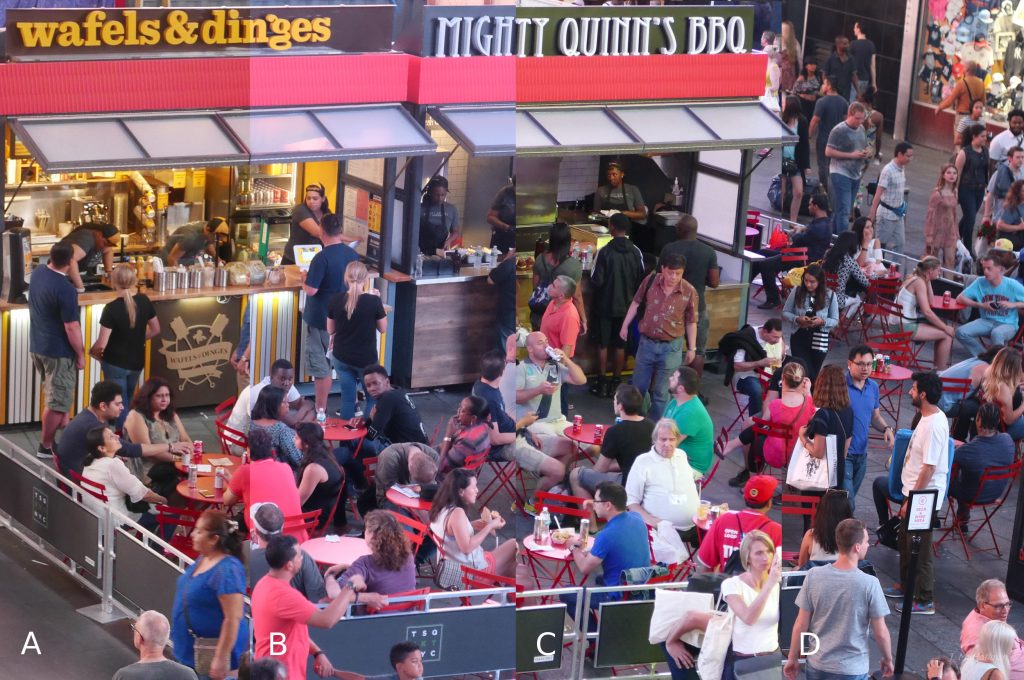
You can also compare the complete images: A, B, C, and D. Or look at the unscaled combo image.
These four cameras vary not only in price and capabilities, but in size:

The huge camera at the left is the 7D Mark II, but with the 100-400mm wildlife lens that I use. I put a much smaller lens on the camera when I took it to Times Square. Next is the Fuji X-T1 with 18-135mm lens. Then the Nikon P900, and finally the Panasonic FZ1000. The Panasonic LX100 is in front.
All four cameras — despite their differences — did a fine job in this first test, particularly considering the tricky nighttime Times Square lighting. And I made this composite from JPGs straight from each camera, even though all four support raw. So think of these as the minimum quality you’ll get. All in all, pretty good.
But even though you can get good results from all four cameras, that doesn’t mean they’re identical, as we see from cropping deeply into each shot:




At this pixel-peeping level, we see the increased quality of the Fuji, and, especially, the Canon. (Though the higher pixel count gives the Canon a slight edge over the Fuji, the real reason the Canon did so well here is the fast lens, which let me shoot at ISO 1250.)
But people don’t view pixels. They view photos. How did the four cameras do?
Here’s an analysis of what you get with each, and what you give up, starting with the Fuji.
The Fuji X-T1
The Fuji X-T1 was my favorite camera at the time, even though it pales compared to the newer X-T3 — which I now own. I love the manual controls, the stellar digital viewfinder, the affordable pro-level lenses, the stunning JPGs, and the overall feel of all the X-T cameras. With the 18-135mm lens (about 28-200mm equiv.), even the Fuji X-T1 is a nearly perfect travel camera; the Fuji X-T3 is even better.
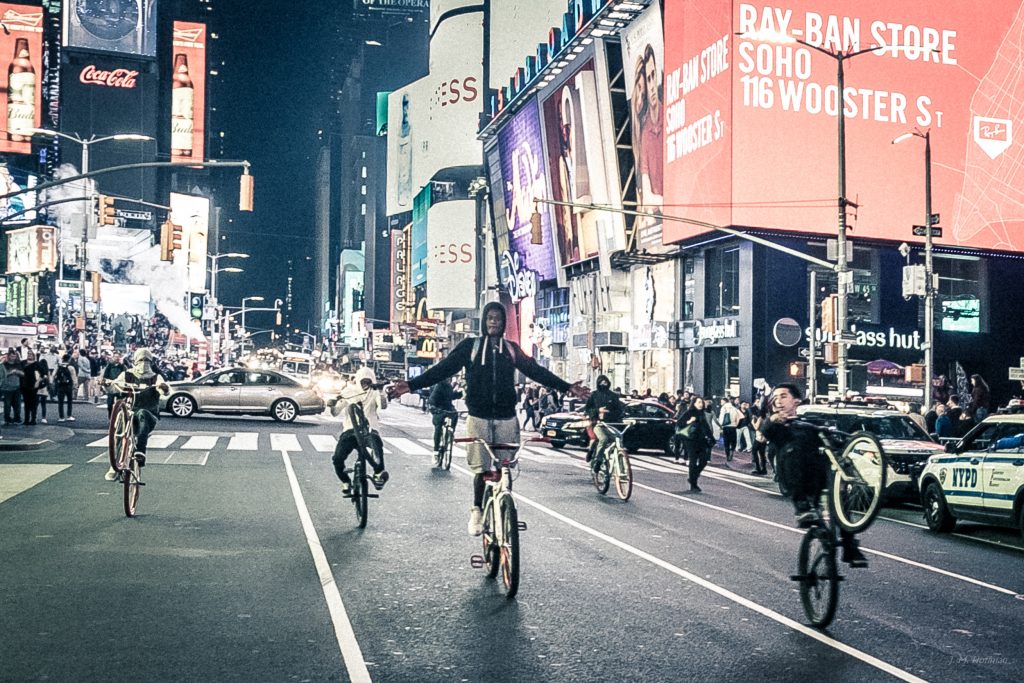
This shot of cyclists in New York would have been almost impossible to get with either of the Panasonic cameras, because they’re just too slow to operate. I was crossing the street to get a completely different shot when these guys appeared out of nowhere, running a red light. With the Panasonics, the cyclists would have been past me by the time I had the camera ready.
Incidentally, here’s the shot I was crossing the street to get:
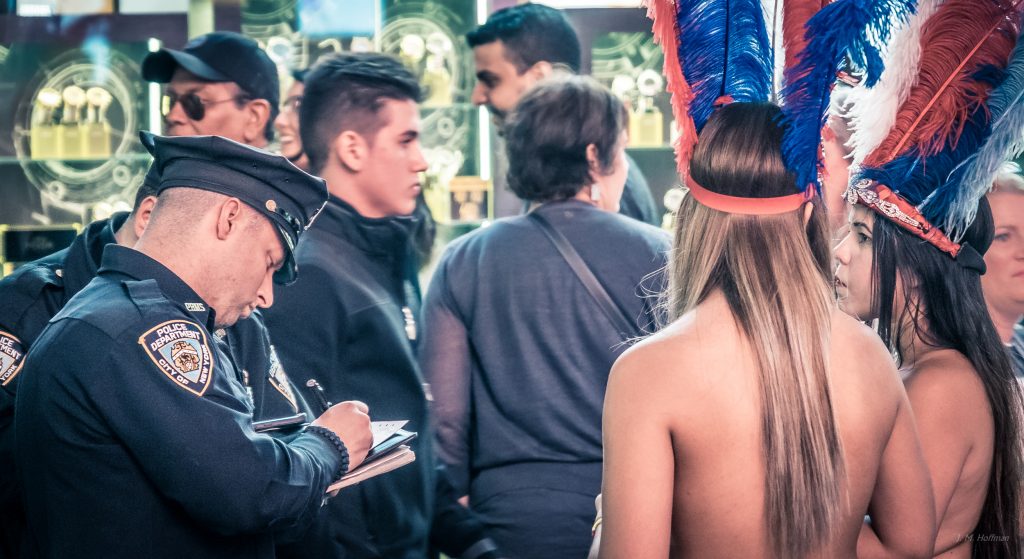
(The source of the conflict here wasn’t clear. Freedom of expression in New York City protects these barely-clad women, who solicit tips in return for selfies with tourists. I asked the cop, who told me the women were outside their designated zone. But I also heard the man supervising the women complain in frustration that he had already “talked to” all the cops, in his mind apparently getting approval for whatever the women were doing.)
You can see more examples from the Fuji in my “Fourteen Hours in Guangzhou” photo exhibit from 2016. Most of the images there, including this one, come from that camera:

Whatever flaws this shot may have, they’re not the fault of the camera.
The Panasonic LX100
I was already pretty familiar with the Panasonic LX100, which, thanks to its tiny size and full manual controls (except for zooming in and out), is my current go-everywhere camera. So except for the test scene above, I didn’t use this in Times Square. For samples, take a look at my “Faces of Jerusalem” exhibit, shot entirely with the LX100, which helped me create photos such as this one at the Church of the Holy Sepulcre:
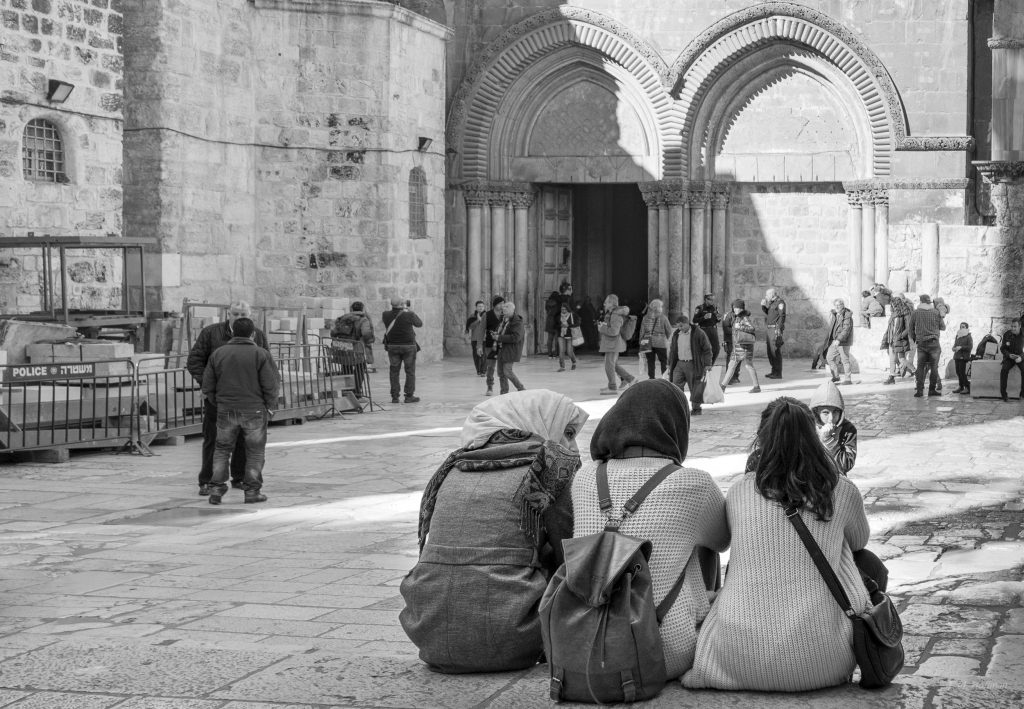
The Panasonic FZ1000
The Panasonic FZ1000 was the real reason I wanted to run this test. With its broad 24-400 range, attractive price, and reasonable form factor, it could be the perfect all-in-one travel camera, but only if the quality was good enough. Was it?
I put it through its paces. (I also ran some nature and wildlife tests with this camera.)
My first opportunity to test the FZ1000 was a street show:
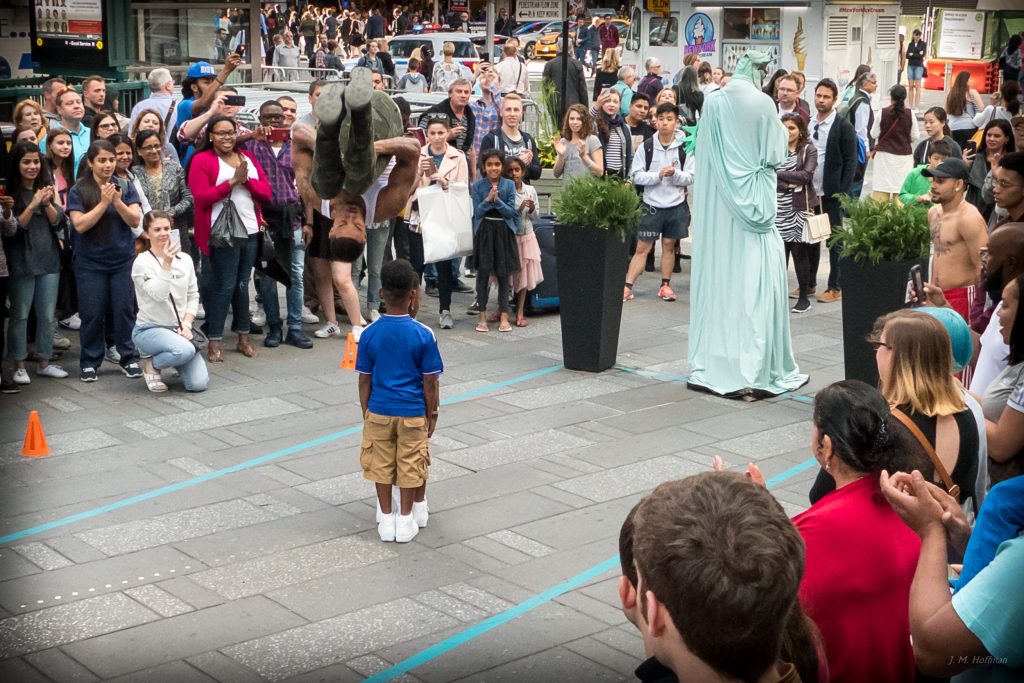
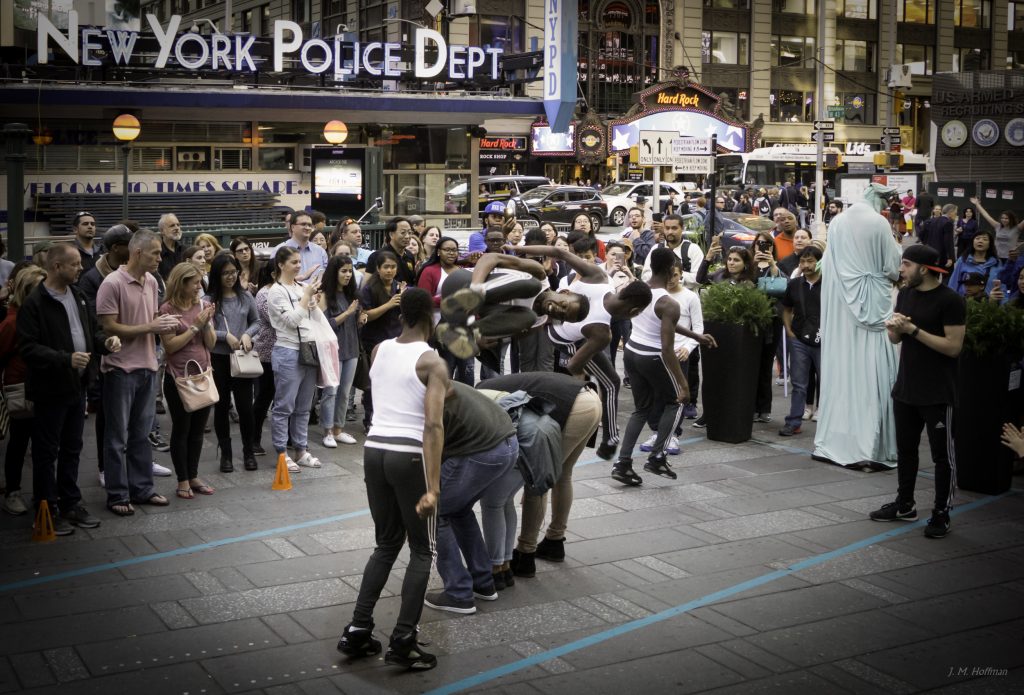
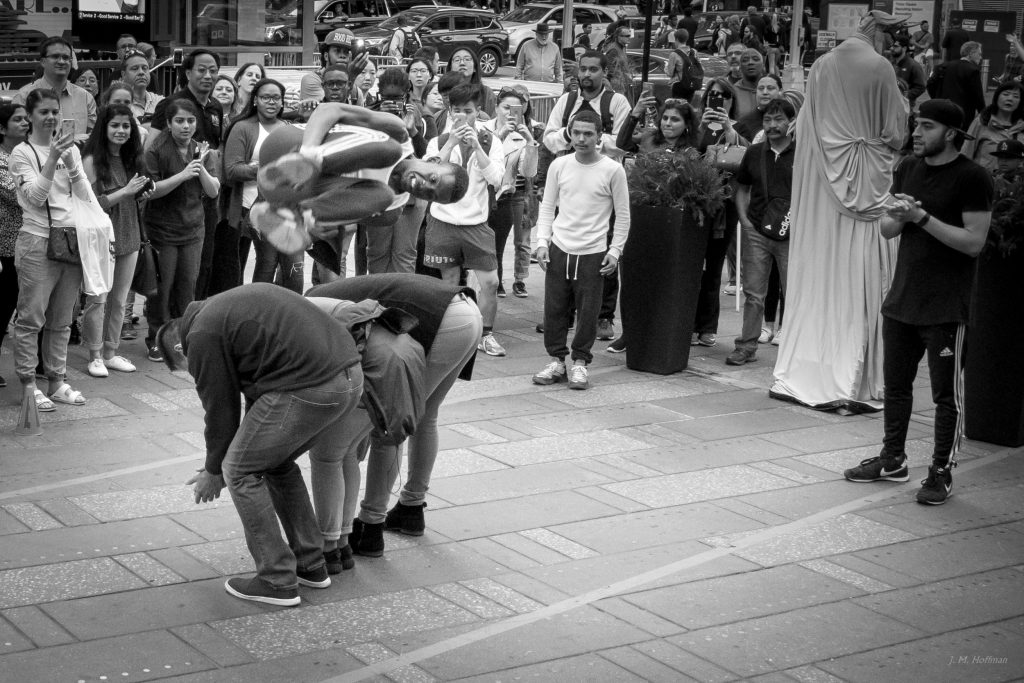
While these images are noisy, they’re also significantly cropped. Here’s the full scene:
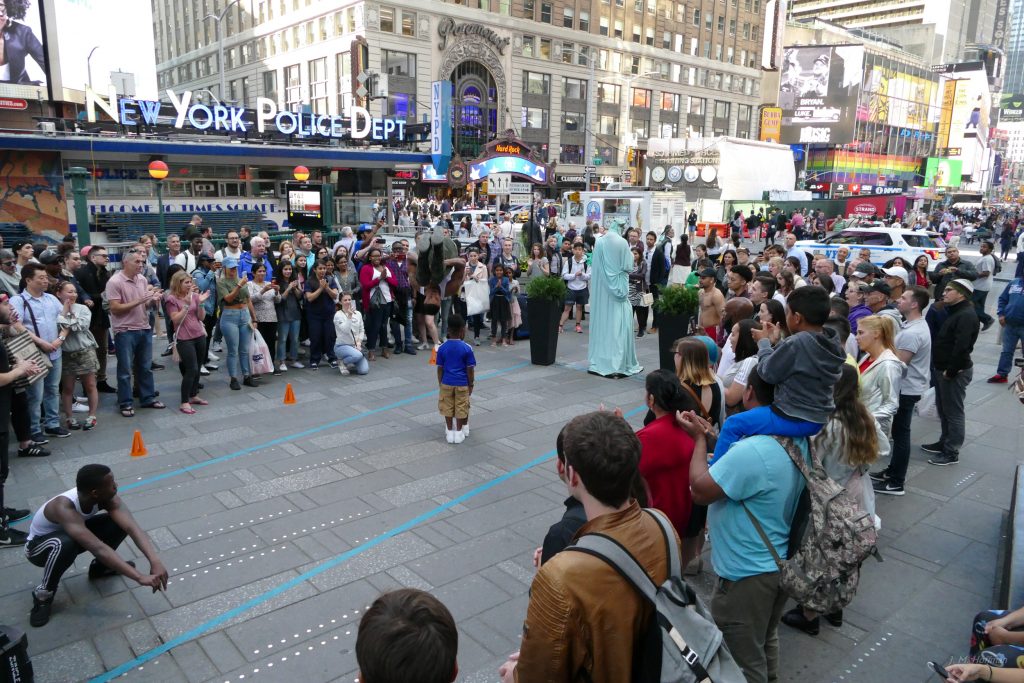
I’m happy with the results. The JPG images out of the camera do just what they should, and the raw files have enough detail to let me crop and process as I like.
And in this case, the fully articulating screen helped me frame a shot over my head which would have been pretty hard to get with my Canon 7Dii.
My next task was to take a G-rated photo of the women, so I waited around until an interesting interaction presented itself:
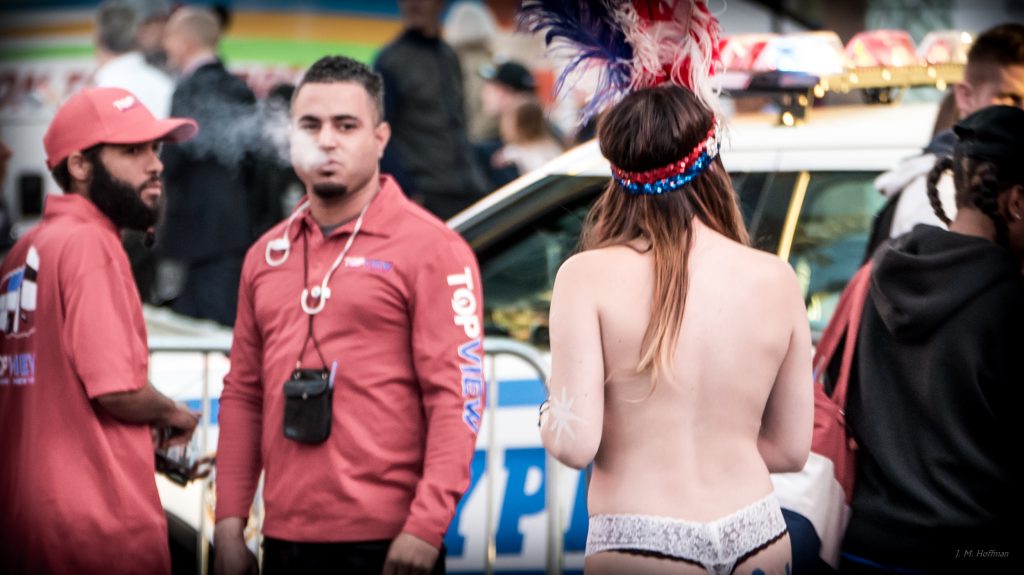
It’s not perfect because I missed focus on the foreground, but — with the help of the 400mm reach on the FZ1000 — I got the shot. (The uncropped PG version is here.) Again, even though I wish I could have blurred the background more, I’m happy with the results. The Panasonic did its job.
The Canon 7D Mark II
As good as these all-purpose zooms are — and they’re good — there’s still no substitute for a fast prime. Here’s a shot from the Canon with a 50mm f/1.8 lens (which, on my 7Dii, behaves like an 80mm f/2.8).
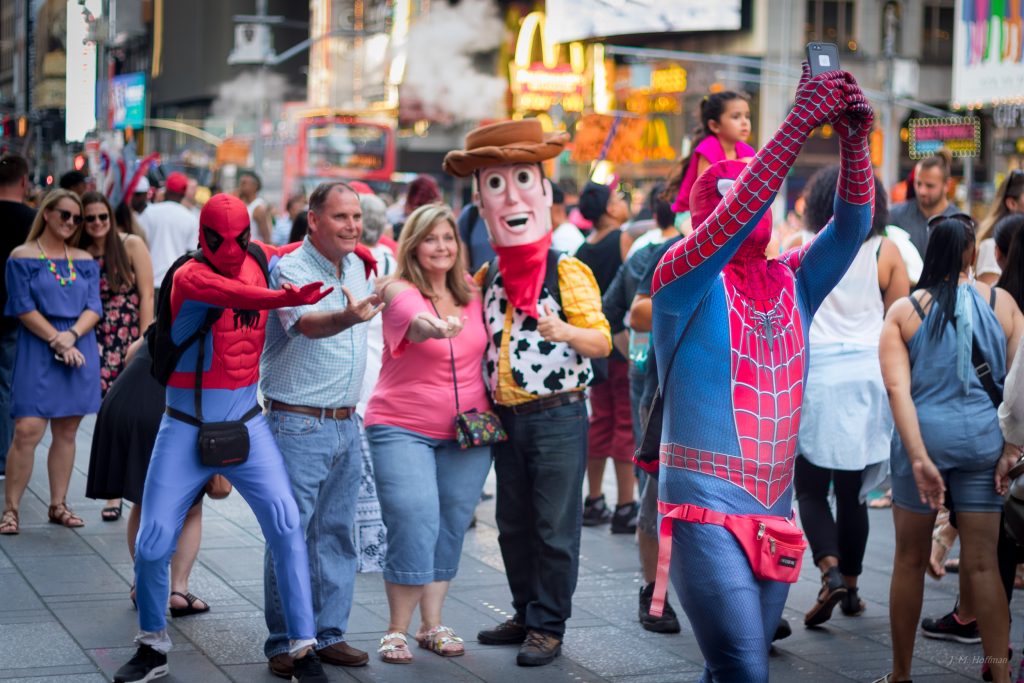
The f/1.8 lens, even on the crop-body 7Dii, helped me isolate the foreground, so the image is interesting; and it let me shoot at ISO 160, so the image is super clean.
Here’s another shot:

On the Panasonics or on the Fuji with the slowish 18-135mm zoom, the pianist here — a passerby, as this was a public piano — would have blended into the background, creating a busy photo of nothing. With the 50mm f/1.8, I was able to turn this into a photo of her, with the other people blending into a blurred background to establish the scene.
At this point it’s worth noting that the 50mm Canon lens I used only costs about $100. (Nikon offers something similar for their line.) If you have a dSLR and don’t have a 50mm lens for it yet, stop reading right now and go buy one.
Here are two more shots from the Canon:
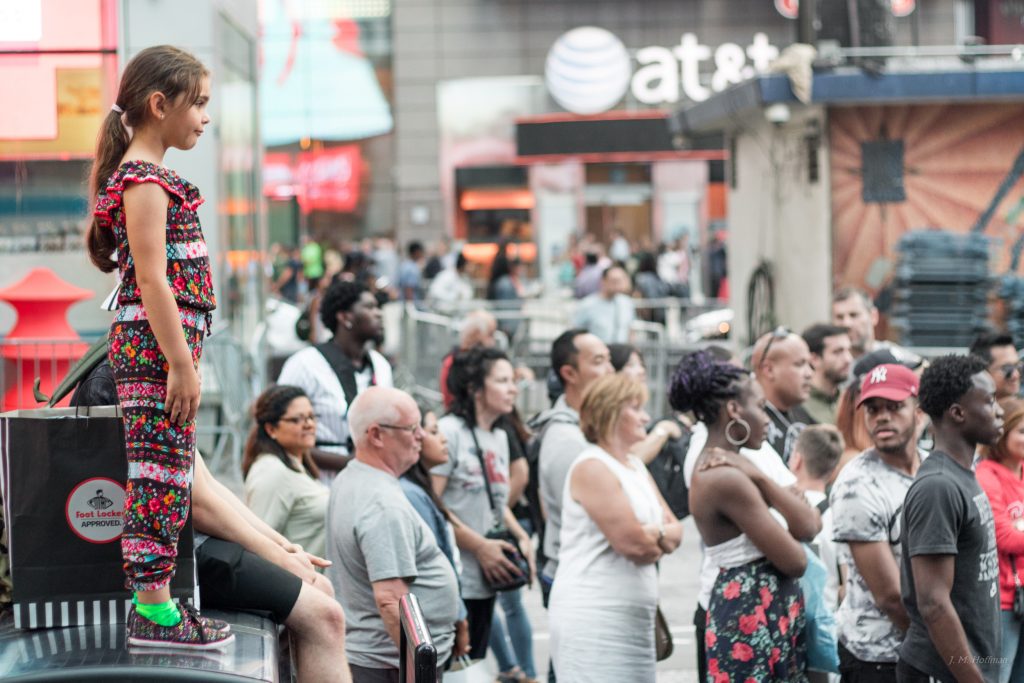
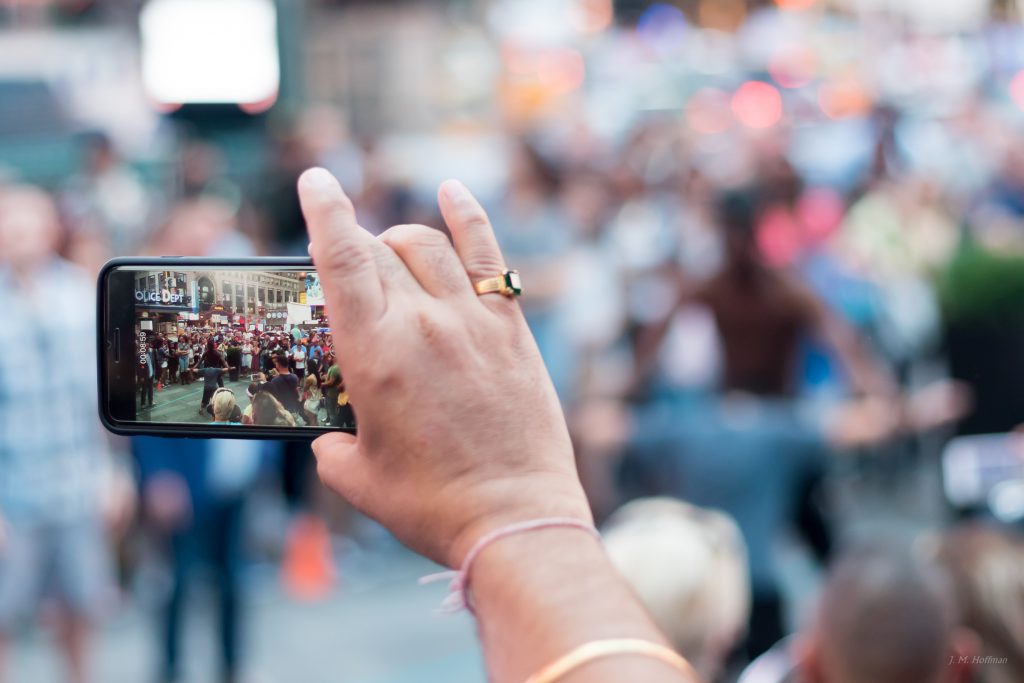
There’s no way the Fuji with the 18-135 or the Panasonics can match the shallow depth of field of the Canon f/1.8.
Results
So in terms of image quality, we see that:
- The Canon with the 50mm lens gives the best image quality by a slight margin, and the best depth-of-field control by a wide margin.
- The Fuji is next in line. You lose some of the depth-of-field (but keep reading); you gain the ability to shoot at wide angle and to zoom in.
- The all-in-one Panasonic FZ1000 has even less control over depth of field, but you gain that huge 24-400mm (equiv.) range, and the image quality is still pretty good.
- The tiny Panasonic LX100 has better depth-of-field control than the FZ1000 (about as much as the Fuji, but less than the Canon), and image quality that’s roughly the same as the FZ1000; but you lose a lot of range to get the tiny form factor.
Discussion
As we just saw, the Canon with the 50mm lens (80mm equivalent on the 7Dii) outperformed the other three in terms of depth-of-field, which can sometimes make or break a photo. But that lens limits you to near telephoto. You can’t get wide-angle shots, and you can’t zoom in very far.
Of course, Canon offers other lenses that give you more flexibility. For $300 there’s a 17-85mm (27-136mm equiv.) lens that will give you results along the lines of the Fuji, though not as sharp and without quite as much reach. For $1,700 you can get Canon’s pro 24-70mm f/2.8 (equivalent to 38-112 f/4.5 on the Canon 7Dii); and they make a pro 28-300mm f/3.5-5.6 (45-480mm f/5.6-9 equiv.) for $2,500. These last two lenses are not small.
The Fuji with its 18-135mm is still my favorite general-purpose walking around combination. It doesn’t give you the beautifully narrow depth of field of an f/1.8 lens, but you gain the ability the frame both wide and telephoto shots.
And if you wanted, the Fuji could do what the Canon does, because you can put a fast prime on the Fuji, too. Fuji has a 50mm f/2.0 that runs about $450, and it’s much sharper than the $100 Canon lens — though I’ve generally found the Canon to be sharp enough. And the Fuji 56mm f/1.2 is really something, though it will set you back $1,000. (If you want fast and sharp on the Canon, you can pick up a pro 50mm f/1.2 lens for about $1,300.)
The two Panasonics will never give you that kind of narrow depth of field. (In this regard, be careful about comparing specs. The Panasonic LX100 at its widest is technically faster than the Canon, at f/1.7. But in terms of the depth of field it produces, f/1.7 on the LX100 is like f/3.4 full-frame. And at the telephoto end the LX100’s f/2.8 is like f/5.6. The f/2.8 of the FZ1000 at its widest is like f/7.6, and that drops to an equivalent of f/10.8 at 400mm.)
The tiny LX100, though limited in reach because it maxes out at 75mm (equiv.), offers enough quality that you can get a good shot with a camera that won’t weigh you down. And you’ll never look conspicuous with the LX100. (That’s why I used it for my Faces of Jerusalem project.) It gives about as much control over depth of field as the Fuji combo.
The FZ1000 offers less depth-of-field control than the Fuji or the LX100, to say nothing of the Canon, but its increased pixel count gives it more detail than the LX100 if you need it. And its huge zoom range gets you five times closer than the LX100, and twice as close as the Fuji.
It’s clear that the LX100, thanks to its small size, offers something none of the others can. And it’s equally clear that a fast-prime — whether on a dSLR like the Canon or on a mirrorless like the Fuji — also offers something unique.
But, surprisingly, the choice between the Fuji X-T1 with 18-135mm and the Panasonic FZ1000 is harder. In terms of image quality, the Fuji comes out ahead in its range, but the Panasonic zooms in closer. And they both offer raw, perhaps making the amazing Fuji JPGs less valuable. For many people, the biggest differences between the two cameras will be in terms of usability.
The Fuji is simply a joy, with full manual controls, and, importantly, a manually controlled zoom. You can go from 18mm to 135mm in a split second. By contrast, the Panasonic relies on electronic dials and an electronic zoom, which makes zooming much slower and less accurate.
Another big difference is that the Fuji’s viewfinder is stunning and the Panasonic’s is average. This can make it more enjoyable to spend time looking through the Fuji.
The Bottom Line
All of this brings us back to the question of how much quality you lose by opting for an all-in-one consumer camera over a pro combo.
Disregarding the Canon with 50mm lens and the tiny LX100 — both of which are pretty specialized — we’re left with the Fuji X-T1 / 18-135mm combo and the Panasonic FZ1000. And it turns out that it’s a trade off. The Fuji has better image quality and better usability. The Panasonic has a broader zoom range while still offering acceptable quality, at about half the price.
For me, the usability of the Fuji X-T1 trumps the extended range of the Panasonic FZ1000, but that’s because I put a 100-400mm lens on my Canon 7Dii for serious wildlife shots. If I can only bring one camera with me on a trip, I usually choose the X-T1. But if I thought there’d be good wildlife viewing, I might pick the Panasonic FZ1000.
Equipment
For this trial I rented cameras from Lensrentals. I’ve used them before, and have always been very happy, so if you’re looking to try out equipment, or if you only need something for a little while, give them a shot.
Here’s how to buy the main equipment in this post:
- Canon 7D Mark II Body
- Canon 50mm f/1.8 lens
- Fuji X-T1 with 18-135mm lens
- Panasonic Lumix DMC-FZ1000
- Panasonic DMC-LX100
And here’s the other equipment I mention in passing:
- Nikon Coolpix P900
- Canon 100-400mm “L” Mark II lens
- Canon 50mm f/1.4 lens
- Canon f/1.2 “L” lens
- Fuji 50mm f/2.0 lens
- Fuji 56mm f/1.2 lens
What do you think?
[Originally posted to J.M. Hoffman Photography in July, 2017.]
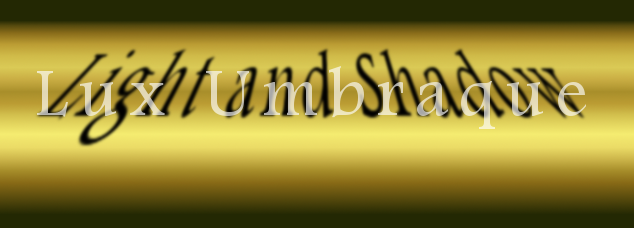



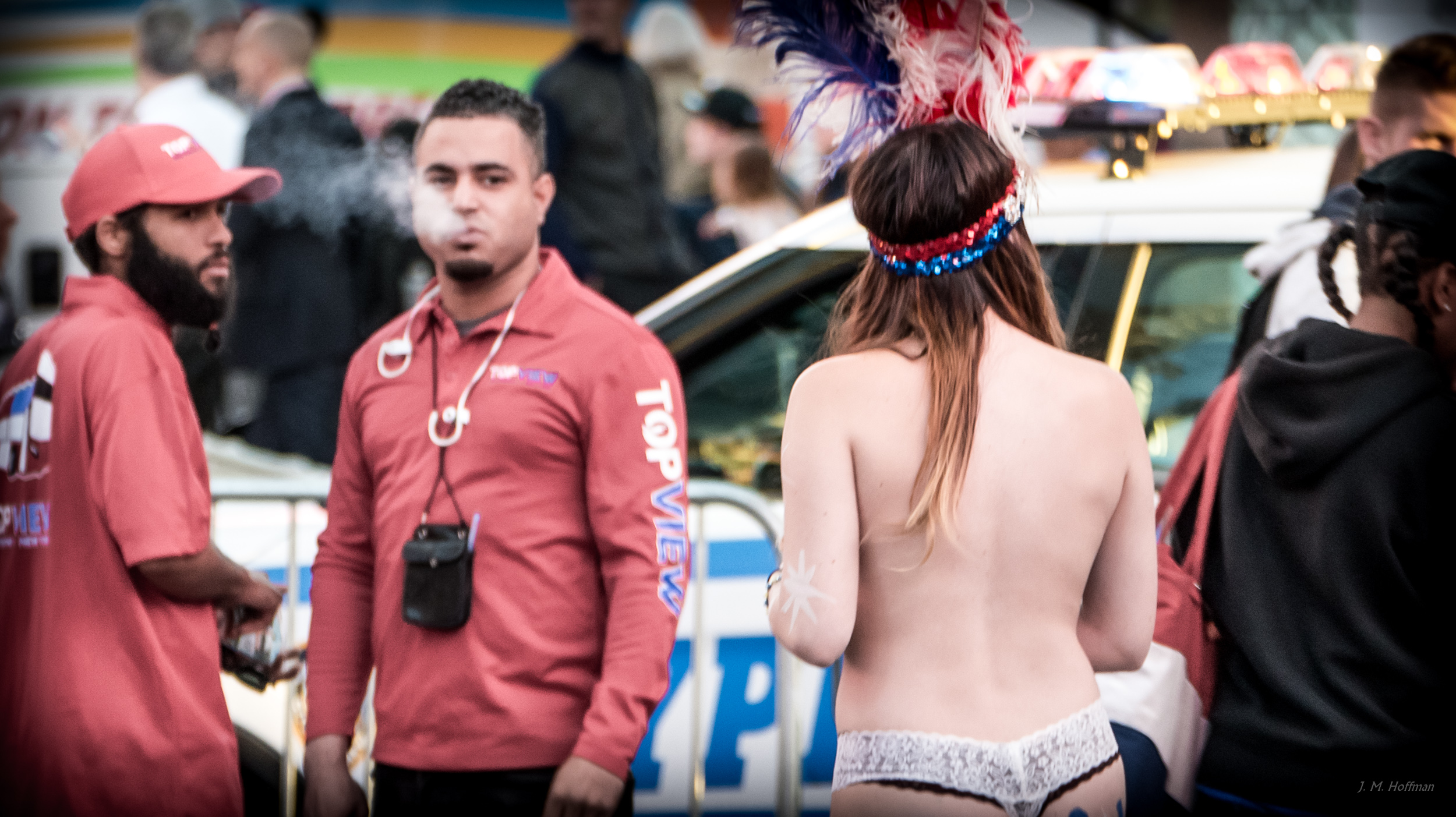
One thought on “Can You Tell the Difference? Travel Cameras”